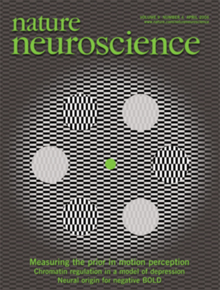Noise characteristics and prior expectations in human visual speed perception
Alan A. Stocker and Eero P. Simoncelli
Published in: Nature:Neurosciencevol 9, num 4, pp 578-585, April 2006.
doi: 10.1038/nn1669
© Macmillan Magazines Ltd.
Related publications:
• Bayesian model and adaptation:
nips05
• Physiological instantiation of Bayesian motion model:
Chalupa03
• Previous (Gaussian) Bayesian perceptual model:
NN02,
PhD93,
arvo94,
arvo92
• Bayesian multi-scale optical flow computation:
Jähne98,
cvpr91

Human visual speed perception is qualitatively consistent with a Bayesian observer that optimally combines noisy measurements with a prior preference for lower speeds. Quantitative validation of this model, however, is difficult because the precise noise characteristics and prior expectations are unknown. Here, we present an augmented observer model that accounts for the variability of subjective responses in a speed discrimination task. This allowed us to infer the shape of the prior probability as well as the internal noise characteristics directly from psychophysical data. For all subjects, we found that the fitted model provides an accurate description of the data across a wide range of stimulus parameters. The inferred prior distribution shows significantly heavier tails than a Gaussian, and the amplitude of the internal noise is approximately proportional to stimulus speed and depends inversely on stimulus contrast. The framework is general and should prove applicable to other experiments and perceptual modalities.
New & Views article by Matteo Carandini (pdf, 385k) / ScienceNOW press release
Online Publications